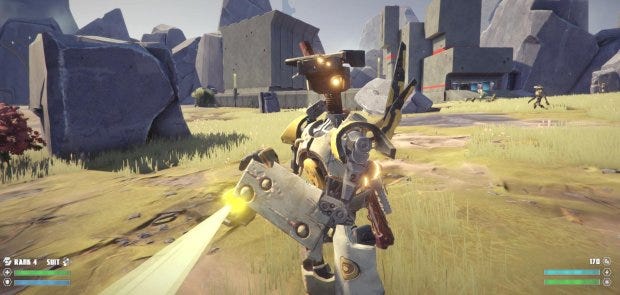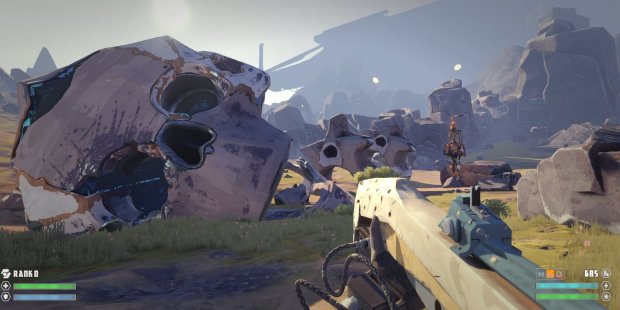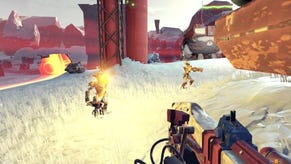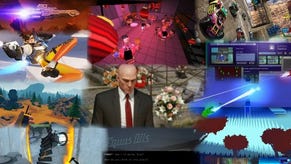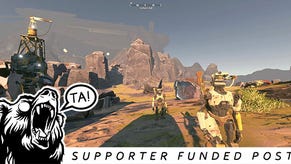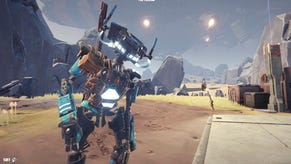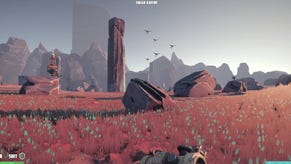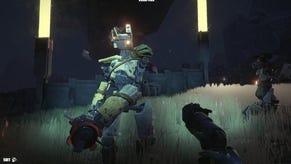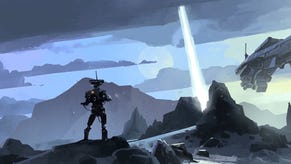We talk to Big Robot's Jim Rossignol about The Signal From Tölva
Sir, You Are Being Confronted
He's a difficult man to pin down, but we managed to secure a world exclusive interview with the project lead behind The Signal From Tölva [official site], one Jim Rossignol. After months of negotiations he agreed to speak to us, divulging thoughts and feelings about the game that will most likely kill him and all involved. Now, some people are going to say that there's a conflict of interests here, what with Rossignol coincidentally being a director and co-founder of Rock, Paper, Shotgun, which is an outrageous accusation that impugns our integrity, wholly accurately.
John: Right, let's get this over with. Tell me about Sir You Are Being Hunted 2. (I'm going in combative.)
Jim: I'm not going to discuss unannounced projects at this time. *folds arms* Perhaps we need my PR manager to oversee this interview.
John: Come on in, the ghost of Genghis Khan.
Jim: He conquered Asia, he knows how to market your indie game.
John: The Signal From Tolva. You couldn't find a more difficult to remember name?
Jim: Sorry, I need to be more mindful of your failing faculties. Let's just call it Robot Game 2. But in all seriousness: The Signal From Tölva is a VERY CLEVER name, which at some point someone will recognise, and I shall be famous. Also I know how to type ö
John: I only know how to type ø. Can you make it Tølva?
Jim: That's very offensive, John.
John: You hate the Nords.
Jim: You're the one messing with their circular letters. If there's one thing they fucking hate, it's that.
John: I've played it, and it's not terrible. You get to be a robot, or indeed another robot, or that robot over there. But why, Jim? Why?
Jim: Why do you get to be a robot? Or why did we make an open-world shooter set in an alien world in which you play a remotely controlled robot on a journey into space mystery? I mean the answer to both of those questions is: because it seemed like a good idea at the time. I think that's the main reason behind all indie game development, frankly. And I'll be talking about it in my GDC presentation: Ideas, And How They Seem Good At The Time: A Primer.
I've actually been tinkering with the idea of talking more about game development once this big crunch thing is done, and I think my main lesson learned is that in a small team like Big Robot everything is a function of the skills and interests of the members of that team. So compared that to a AAA team where people are hired to perform specific roles as well as for their specific skills, when the team is smaller, you have to make do with what people are able to achieve, and what they want to actually make. I think both Sir and Tölva are direct expressions and functions of that.
The game is perhaps relatively ambitious because I really like making Tom [Betts] work hard for years at a time with no break, and he seems to be fine with that, for example. (Not sure if I am joking about that.) When we sat down to make a new game, there were some things we knew we wanted to do, and some things we knew we could do. So we tried to squash those things together with our useless, fleshy hands. The result is we made something that builds on our systems-driven robot freeform worldiness, as seen in Sir to some extent, but also it's very pretty. That's because we hired an artist. Lovely chap.
Sir had a tremendous atmosphere and strong theme, but the presentation and individual assets were much weaker than they might have been if we'd had the resources to do lots of lovely art. With some increased capacity in that department I think the results speak for themselves.
John: Why robots instead of humans? That's twice now it's been all robots where the humans are meant to go. What about this interests you?
Jim: Well we did briefly consider humans for the next thing - and I do think that humanoids, if not humans, are really important to a first-person game because it gives you a relatable sense of proportion and scale. But the answer there really ended up being in the source material: we wanted to base the game on some lovely sci-fi art. We knew we wanted a big fancy sci-fi theme, and we were lucky enough to catch the attention of tremendous Rockstar artists Ian McQue (which we've banged on about at length) and his robots are just beautiful. I mean they're just about the best robots I've seen, and so when he offered to design them that pretty much sealed the deal. There are other reasons why that works, too: robots have a certain inhuman jerkiness to them that means we don't have to have the world's most technical animators to make them work. And we've all see how people react to badly-animated humans over the years. Also - I don't know if you noticed this - but robots explode really well. Humans are more sort of red and wet when they break. Eugh.
John: So it's not because you are really a robot?
Jim: Well I plan to be. But I am still made of flesh for some reason.
John: Lots of people are going to compare Tølva to Far Cry, because of its camp-clearing ways. Is that unhelpful for you?
Jim: It's a pleasant enough comparison. I have enjoyed aspects of the Far Cry games, and it's fun to think we can be uttered in the same breath. However I think we're in danger of pulling a short straw in terms of being compared to big games like that because we are a handful of men in bedrooms and Ubisoft has hundreds of millions of dollars. My feeling is that while that gives people some easy context the initial similarities run out fairly quickly: Tölva is a much more chilled out FPS exploration experience than Ubi's games, and certainly have fewer cutscenes and/or dream sequences. My influences are definitely much more Stalker and the like, rather than those games, but at the same time I recognise that stuff like icons on a map is just a really straightforward way of getting people exploring your world.
John: Tell me about the magic buildings. For reader context, these are small metal containers that when entered are a like if the TARDIS were a maze.
Jim: They were a bit of a whim at first, but they ended up being rather good at underlining the theme of spooky weirdness that runs through the game. The initial world design was "alien highlands", which I think we achieved fairly well across the various regions of the game, but as we got further in we realised that contrasting that with some interior spaces would be fun and interesting. Initially James prototyped some obstacle-course things, so that the interior spaces would be a break from hiking and shooting, but that didn't quite sit right with us. Eventually he began to use clever seamless portaling stuff to create impossible mazes, where you would drop down and down and appear at the top of a tower, for example. I found that thematically pleasing (not to mention consistent) because the story of Tölva is about a world that isn't quite right, and where things are glitchy and inexplicable, in a way that disturbs even AI intelligence. And so the interiors underline that. They are strange and difficult mazes. Not puzzles as such - as we were discussing just this morning - but challenging and impossible spaces that you can explore if you want to. None of them are crucial to the game or the plot, and I like that many people won't even see the secret in one of them.
John: Because it makes you feel superior?
Jim: Yes, basically. That's what game development is all about.
John: You've been on the other side of receiving reviews now. The critic got critiqued. Has that affected how you approached development?
Jim: Yes. We've focused a lot more on making things accessible (by making the gamepad actually useful, for example) and in ironing out more of the rough edges that we saw in Sir. I don't think the critiques really change much about what we make, or why, or influence design beyond tweaks and balance changes, but they definitely change how we work. We've been far more conscientious this time, and I think it shows in the production quality of all the things. People really care about how well a game is put together, and we've tried to rise to those demands. Actually, there is one thing from Sir critique that definitely influenced me a lot, which was people saying they found being hunted constantly too stressful. I don't think that changes anything about Sir - that was the point of the game, and hence the design - but it did make me want to make Tölva a more relaxed experience. I think we've achieved that. It's just a really lovely place to spend time.
John: We're very busy over the next few months. Do you want to do the RPS review for Tõlva?
Jim: I'm not sure I can remember how. You just talk about an old girlfriend and then check if it has a FOV slider, yeah?
John: Yes Kieron.
Jim: Kieron Gillen's blog is a cool website btw, you must really like working for it.
John: It's a daily honour. Thanks for your time.
The Signal From Tôlva is out in April, and even has a Steam page.
Disclosure: This is beyond a conflict of interests - Jim co-owns RPS and is a director of the company, so we don't have a hope of balanced coverage of Tòlva. It'd be ridiculous to ignore it, so we're just embracing the farce of it all. Bear that in mind when you read any of our coverage, although when it comes to a review we'll give it to an independent freelancer who has no relationship with Big Robot whatsoever.
